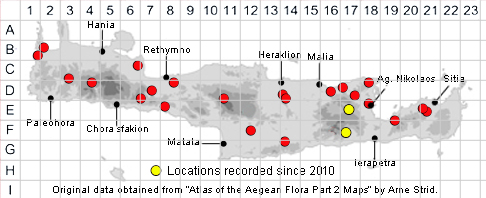SPECIES DESCRIPTION
CENTAUREA SOLSTITIALIS
Family and Genus:- See- COMPOSITAE/Subgen. SOLSTITIARIA
Common Name:- St. Barnaby's thistle, Yellow star-thistle
Homotypic Synonyms:- For a list of Homotypic Synonyms Click here
Meaning:- Centaurea (Gr) Centaur, Centauros. The centaur Chiron was cured of a
hoof wound with this plant.
Solstitialis (L) Of midsummer (flowering about 11 July , St. Barnabas'
Day).
General description:- Medium to tall, greyish-downy biennial.
Stems:-
1) 30-100 cm, erect, much branched from lower half, usually greyish-tomentose;
branches long, winged.
Leaves:-
1) Scabrid, and arachnoid or lanate, or greyish-tomentose.
a) lower, usually lyrate to pinnatifid, with triangular-oblong lobes.
b) upper, linear-lanceolate, entire, mucronate.
Flowers:-
1) Capitula, solitary.
2) Involucre, 7-12(-15) mm diam, usually ovoid-globose.
3) Bracts, broadly ovate.
4) Appendages, not decurrent, short, the apical spine 10-15(-30) mm, with basal
spines c. 3 mm.
5) Florets, usually yellow, eglandular, uniform.
Fruit:- Achenes, c. 2·5 mm, black; pappus up to 5 mm.
Key features:-
1) Achenes, c. 2·5 mm, shorter than to as long as pappus.
2) Involucre, 7-12 mm diam.
3) Leaves, lanate or greyish-tomentose.
4) Florets, eglandular.
Habitat:- Deciduous and evergreen scrub, field margins, olive groves, open
coniferous woodland, wasteground. 0-600(-1100) m.
Distribution:- Throughout Greece, S. Europe, and SW to C Asia. Naturalised or
casual elsewhere. Scattered across Crete, not common.
Flowering time:- Mainly May-July, occasionally to Oct.
Photos by:- Steve Lenton
